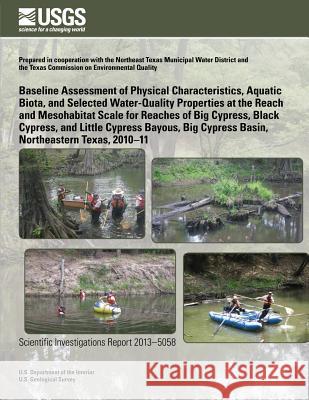Baseline Assessment of Physical Characteristics, Aquatic Biota, and Selected Water-Quality Properties at the Reach and Mesohabitat Scale for Reaches o » książka
Baseline Assessment of Physical Characteristics, Aquatic Biota, and Selected Water-Quality Properties at the Reach and Mesohabitat Scale for Reaches o
ISBN-13: 9781500267766 / Angielski / Miękka / 2014 / 100 str.
Baseline Assessment of Physical Characteristics, Aquatic Biota, and Selected Water-Quality Properties at the Reach and Mesohabitat Scale for Reaches o
ISBN-13: 9781500267766 / Angielski / Miękka / 2014 / 100 str.
(netto: 76,40 VAT: 5%)
Najniższa cena z 30 dni: 79,56
ok. 16-18 dni roboczych.
Darmowa dostawa!
In 2010 and 2011, the U.S. Geological Survey (USGS), in cooperation with the Northeast Texas Municipal Water District and the Texas Commission on Environmental Quality, did a baseline assessment of physical characteristics and aquatic biota (fish and mussels) collected at the mesohabitat scale for reaches of Big Cypress, Black Cypress, and Little Cypress Bayous in the Big Cypress Basin in northeastern Texas, and measured selected water-quality properties in isolated pools in Black Cypress and Little Cypress. All of the data were collected in the context of prescribed environmental flows. The information acquired during the course of the study will support the long-term monitoring of biota in relation to environmental flow prescriptions for Big Cypress Bayou, Black Cypress Bayou, and Little Cypress Bayou. Data collection and analysis were done at mesohabitat- and reach-specific scales, where a mesohabitat is defined as a discrete area within a stream that exhibits unique depth, velocity, slope, substrate, and cover. Biological and physical characteristic data were collected from two sites on Big Cypress Bayou, and one site on both Black Cypress Bayou and Little Cypress Bayou. The upstream reach of Big Cypress Bayou (USGS station 07346015 Big Cypress Bayou at confluence of French Creek, Jefferson, Texas) is hereinafter referred to as the Big Cypress 02 site. The downstream site on Big Cypress Bayou (USGS station 07346017 Big Cypress Bayou near U.S. Highway 59 near Jefferson, Tex.) is hereinafter referred to as the Big Cypress 01 site and was sampled exclusively for mussels. The sites on Black Cypress Bayou (USGS station 07346044 Black Cypress Bayou near U.S. Highway 59 near Jefferson, Tex.) and Little Cypress Bayou (USGS station 07346071 Little Cypress Bayou near U.S. Highway 59 near Jefferson, Tex.) are hereinafter referred to as the Black Cypress and Little Cypress sites, respectively. A small range of streamflows was targeted for data collection, including a period of low flow during July and August 2010 and a period of very low flow during July 2011. This scenario accounts for variability in the abundance and distribution of fish and mussels and in the physical characteristics of mesohabitats present during different flow conditions. Mussels were not collected from the Little Cypress site. However, a quantitative survey of freshwater mussels was conducted at Big Cypress 01. Of the three reaches where physical habitat data were measured in 2010, Big Cypress 02 was both the widest and deepest, with a mean width of 62.2 feet (ft) and a mean depth of 5.5 ft in main-channel mesohabitats. Little Cypress was the second widest and deepest, with a mean width of 49.9 ft and a mean depth of 4.5 ft in main-channel mesohabitats. Black Cypress was by far the narrowest of the three reaches, with a mean width of 29.1 ft and a mean depth of 3.3 ft in main-channel mesohabitats but it had the highest mean velocity of 0.42 feet per second (ft/s). Appreciably more fish were collected from Big Cypress 02 (596) in summer 2010 compared to Black Cypress (273) or Little Cypress (359), but the total number of fish species collected among the three reaches was similar. Longear sunfish was the most abundant fish species collected from all three sites. The total number of fish species was largest in slow run mesohabitats at Big Cypress 02, fast runs at Black Cypress, and slow runs at Little Cypress. The catch-per-unit-effort of native minnows was largest in fast runs at Big Cypress 02. More species of native minnows, including the ironcolor and emerald shiner, were collected from Little Cypress relative to all other mesohabitats at all sites.
Zawartość książki może nie spełniać oczekiwań – reklamacje nie obejmują treści, która mogła nie być redakcyjnie ani merytorycznie opracowana.











